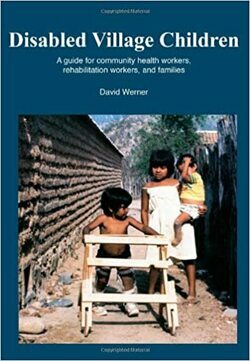Disabled Village Children: A Guide for Community Health Workers, Rehabilitation Workers, and Families
This book represents the fruits of a decade of the efforts of PROJIMO, and aims to empower and inspire disabled village workers in their efforts to build community health and rehabilitation programs.
The story of Pepe’s crutches is an example of the lessons we have learned that helped to create this book. We are a group of village health and rehabilitation workers who have worked with people in farming communities of western Mexico to form a ‘villager-run’ rehabilitation program. Most of us on the rehabilitation ’team’ are disabled ourselves.
From our experience of trying to help disabled children and their families to meet their needs, we have developed many of the methods, aids, and ideas in this book. We have also gathered ideas from books, persons, and other programs, and have adapted them to fit the limitations and possibilities of our village area. We hope this book will be useful to village people in many parts of the world. So we have asked for cooperation and included suggestions from community program leaders in more than 20 countries.
This book was not written by experts, and then ‘‘field tested’ with community workers. Instead, it was written by and with community and then reviewed and corrected by experts.
Unlike most handbooks for village workers and families, this book was not written by ‘professionals’ and then ‘field tested’. Instead, it grew out of the practical experience of a team of disabled village health workers as we looked for information to help meet the most common problems we face.
However, a large number of professionals have helped in important ways. Many are well-known leaders in their fields. They include physical and occupational therapists, special educators, nurses, doctors, brace and limb makers, and rehabilitation engineers. They have carefully reviewed and even helped to rewrite sections of this book. Some have also helped to teach and advise our village team.
Reviews
At the Center on Disability Studies at the University of Hawaii, we use Disabled Village Children to teach teachers and family members how to support the related services needs of children with severe disabilities… The book works well for us because it supports simple English with wonderful drawings. Everyone whom we train speaks English as a second language, and everyone appreciates the pictures that illustrate the written concepts. The book clearly explains the most common disabilities and provides good examples of interventions that can be done using locally available materials. We have made wooden and PVC equipment adapted from designs in the book, and used many of the ideas in the book to support the needs of children on very remote islands. The ideas are creative and address basic needs of children with disabilities all over the world.
—Katherine Ratliffe, PhD, PT. , Center on Disability Studies, University of Hawaii
Disabled Village Children is a powerful, engaging, and readable reference for (developing world) health and rehabilitation workers. It provides ideas and techniques relevant for the novice and the veteran, as well as for the interested observer… The power of Disabled Village Children derives from its simplicity as well as from its recurring theme of a “bottom-up” approach to health and rehabilitation in rural communities.
—Marc Krizack, Rehabilitation Consciousness
Disabled Village Children is the benchmark manual on community-based rehabilitation… (Hesperian’s) new series of books on early intervention for children with disabilities are beautiful as well as extremely useful.
—US Agency for International Development
Links
-
English:
- HTML: Disabled Village Children at the David Werner Collection of the Disability Information Resources website of the Japanese Society for Rehabilitation of Persons with Disabilities (JSRPD).
- Buy at Amazon.com ($27.00)
- Buy at Hesperian ($29.95)
-
En Español: El Niño Campesino Deshabilitado
Why is Disabled Village Children an Important Book?
Editor’s Note: In 2021, I asked David about why he thought Disabled Village Children was an important book. Here is an excerpt of our conversation.
|
David Werner |
It’s important because it was written about the same time the World Health Organization had released a book called “Training of Disabled People in the Community” Our whole approach was to respect disabled people as being human and independent potentially and involved in things as other people. And we didn’t want to make a training book telling disabled people what to do and how to do it. We wanted to involve disabled people in figuring out their own solutions and requesting services that they wanted on their terms, and so on. The training of disabled people in the community by the WHO ended up a book kind of micky-mouse. A lot of the assistive devices—they had drawings, but if you tried to make what they drew, it didn’t quite work. Disabled Village Children really pushed WHO to embrace community-based rehabilitation … turned it around from being a service providing instrument for disabled people, to more of inclusion of disabled persons in the process of meeting their own needs, and insisting their inclsion as equals in society. And because of this it has really changed the approach of many, many of the so-called community-based rehabilitation programs the focus of it has really changed and evolved very much in the direction that we tried to take it to. So we feel that we’ve made a big contribution worldwide in that process. And DVC, like WTND is the most used primary health care manuals. Disabled Village Children is now the most widely used community rehabilitation manuals in the world. |



